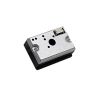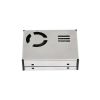PM Sensor
Infrared Particulate Matter Sensor, PM2.5
Laser Particulate Matter Sensor, 0.3-10μm
Dust Sensor Module, PM2.5/Temperature/Humidity/VOC/CO2
Dust Detection Sensor, PM0.3-PM10
Automotive Laser Dust Sensor, PM1.0/PM2.5/PM10
Indoor Infrared Dust Sensor, TTL/PWM Output
PM sensor (particulate matter sensor) and dust sensor are key devices for monitoring suspended particulate matter (e.g. PM1.0, PM2.5, PM10) in the air, which are widely used in environmental monitoring, indoor air quality control, industrial safety, and smart home applications. SUCH brings together a wide range of particulate matter detection sensors, including laser and infrared types, to meet a variety of needs, from high-precision air quality monitoring to portable measurements for home use.
PM Sensor / Dust Sensor Working Principle
Infrared PM sensor:
 Infrared PM sensors are designed based on the principle of light scattering. Light scattering occurs when infrared light hits particulate matter. The sensor detects the signal change of the scattered light and calculates the concentration of the particulate matter based on the intensity of the electrical signal. The electrical signal is proportional to the intensity of the detected light. The electrical signal is amplified by an amplifier, and then a microcontroller performs a series of calculations and calibrations to finally output the particle concentration value.
Infrared PM sensors are designed based on the principle of light scattering. Light scattering occurs when infrared light hits particulate matter. The sensor detects the signal change of the scattered light and calculates the concentration of the particulate matter based on the intensity of the electrical signal. The electrical signal is proportional to the intensity of the detected light. The electrical signal is amplified by an amplifier, and then a microcontroller performs a series of calculations and calibrations to finally output the particle concentration value.
Laser PM sensor:
 The laser particulate matter sensor contains a laser light source and a photodetector, which collects the intensity of the scattered light in real time. When the air containing particulate matter flows through the sensor pipe, the particulate matter in the air inside the pipe will cause laser scattering, and the photoelectric element collects the changes in the intensity of the scattered light. The subsequent acquisition circuitry calculates the equivalent particle size of the particles and the number of particles of different sizes per unit volume based on MIE theory.
The laser particulate matter sensor contains a laser light source and a photodetector, which collects the intensity of the scattered light in real time. When the air containing particulate matter flows through the sensor pipe, the particulate matter in the air inside the pipe will cause laser scattering, and the photoelectric element collects the changes in the intensity of the scattered light. The subsequent acquisition circuitry calculates the equivalent particle size of the particles and the number of particles of different sizes per unit volume based on MIE theory.
Advantages of PM Sensors/Dust Sensors
PM sensors are characterized by high sensitivity, fast response time and high measurement accuracy, enabling real-time air quality monitoring. Laser dust sensors are highly accurate and stable over time. Infrared dust sensors are low-cost, low-power and compact. Both support continuous online detection and are easy to integrate into a wide range of end devices, making them suitable for a variety of ambient air quality monitoring needs.
PM Sensor/Dust Sensor Applications
PM sensors are widely used in air purifiers, indoor air quality monitors, smart city environmental monitoring, industrial dust prevention and control, HVAC systems, automotive on-board air management, tunnels and warehouses, safety monitoring, air management in public places, wearable or portable air testing equipment and other fields, to help improve the level of air quality management to protect human health and industrial safety.





















